What is it about?
What difference does bicycle infrastructure make? Does it encourage people to bike more? Using a large dataset of GPS trajectories of bicycle trips and fine-grained network data covering the city of Copenhagen, Denmark, we find a large effect of infrastructure provision on the volume of bicycle traffic. We find that it does make quite a lot of difference. The extensive Copenhagen bicycle lane network has caused the number of bicycle trips and the bicycle kilometers traveled to increase by 60% and 90%. This translates into an annual benefit of €0.4M per km of bicycle lane owing to changes in generalized travel cost, health, and accidents. Our results thus strongly support the provision of bicycle infrastructure. It matters a lot, which bicycle infrastructure cities provide. We find a difference in the generalized cost of cycling of more than a factor eight between the best and the worst infrastructure types. Thus, the type and the location of infrastructure are very important.
Featured Image

Photo by FABIO VILHENA on Unsplash
Why is it important?
If more bike travel by bicycle rather than by car, it will help to improve public health and reduce traffic congestion, noise, and air pollution as well as the climate impact of urban transportation. Provision of bicycle-friendly infrastructure is a primary means to achieving this.
Perspectives
This is exciting and fun research. The topic of bicycling and urban policy is highly relevant and engaging for many audiences. At the same time, we are making progress in basic science. The paper uses a new kind of model that my co-authors and I have developed in my Advanced Grant project for the European Research Council. This model allows us to integrate massive amounts of information: the whole bicycle-relevant network of Copenhagen at a very high resolution as well as a very large database of very precise GPS traces of bicycle trips through the network. The number of routes between any two points in a large network is virtually infinite. It is impossible to list on any computer. Nevertheless, with our new model, we are able to incorporate all these possibilities without making compromises. There is much more to be done, developing these models. I hope to be able to do that in future projects.
Mogens Fosgerau
University of Copenhagen
Read the Original
This page is a summary of: Bikeability and the induced demand for cycling, Proceedings of the National Academy of Sciences, April 2023, Proceedings of the National Academy of Sciences,
DOI: 10.1073/pnas.2220515120.
You can read the full text:
Resources
Contributors
The following have contributed to this page










